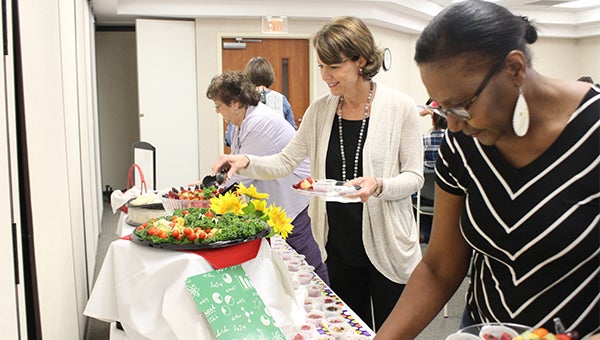Healthy lunch options help children develop
Published 9:53 am Wednesday, September 28, 2016

- SCHOOL LUNCHES: From right, Arletha Ross and Ali Hopson get their healthy lunch of chicken pita pockets and turkey wraps Friday at the Healthy Woman Lunch Program at Merit Health River Region Medical Center.
Food high in sugar maybe the type of food children gravitate toward, but healthy meals can be delicious too.
Last week’s Healthy Woman Lunch Program at Merit Health River Region Medical Center featured healthy food ideas for school lunches in presentations by Erin Bennett and Ali Hopson.
To build a healthy lunchbox, Hopson, a registered dietician, said the meal could be broken into five parts: whole grains, protein, fruit, vegetables and dairy.
“If nothing else, if you leave today saying ‘I’m going to try to incorporate more fruits and vegetables,’ you’re doing well,” Hopson said.
Some suggestions for whole grains and protein in lunches include cheese quesadilla, pasta salad, chicken salad and crackers, vegetable soup, pita pizza or rice and black beans. Others foods that can be added to lunch but don’t necessarily fit in a section include trial mix, nuts, string cheese, pretzels or granola bars.
Trying new food is encouraged for children to be more adventurous with their tastes, she said, and making healthy food fun makes it more accessible to children.
“Kids a lot of times eat with their eyes, so if something looks good to them, they’re going to try it,” Hopson said, suggesting food that is more colorful, dips, food cut into shapes and different containers as options.
She encouraged parents to get their children involved in meal planning so they can start setting up good habits.
“Studies show that when kids help plan their lunches they are much more likely to eat,” Hopson said.
Women who attended the lunch packed their own “lunchbox” by making a plate of healthy lunch options that consisted of a chicken pocket pita, turkey wrap, fruit and vegetable kabobs, trail mix, raspberries stuffed with a dark chocolate chip and splash water.
Bennett, a nurse practitioner in the pediatric clinic at River Region, said while good nutrition is important for sound mental and physical development, bad nutrition can negatively impact performance in school.
“They need, not just empty calories so not just chips and junk food, they need good things that are really going to help them develop,” Bennett said. She also reminded parents to not use food, especially junk food, as a reward for good behavior because it can set up bad habits.
Fiber and protein are recommended to keep children full. She recommended 3 to 5 grams of fiber per serving and lean meats like fish and chicken. Protein can be found in foods other than meat like beans, eggs or milk.
She said not to worry about picky eaters as long as they are provided nutritional food.
“They are going to go through growth spurts where they are going to eat more or less, but they’re going to get enough to eat,” Bennett said.
A lot of nutritional choices need to be made based on the child’s age.
For example, milk for babies should be breast milk or formula, toddlers up to age 2 need whole milk, after age 2 low fat or skim milk is recommended and school age children need three servings of dairy a day, she said.
“They need the fat for brain development,” Bennett said of toddlers.
Those who are lactose intolerant or picky can get calcium through iron fortified cereals, oatmeal, yogurt, cheese or orange juice.
Bennett also said she used American Academy of Pediatrics recommendations for how much juice, or any sugary drink, a child should consume based on their age. These drinks include soda, tea, sports drinks and Kool-Aid. Babies under 6 months should not consume sugary drinks at all, 1- to 6-year-olds can have 4 to 6 ounces a day and 7- to 18-year-olds can have 8 to 12 ounces a day, according to the AAP recommendation.
“I would urge you to talk with your kids, if they eat in the cafeteria, talk to them about what they’re eating,” Bennett said. This will help parents know what they’re child has had to eat and drink at school, she said, so the parent can make sure the child isn’t served more of the same at home.
For more information, Hopson suggested the app LaLa Lunchbox, or visiting myplate.gov and produceforkids.com.





